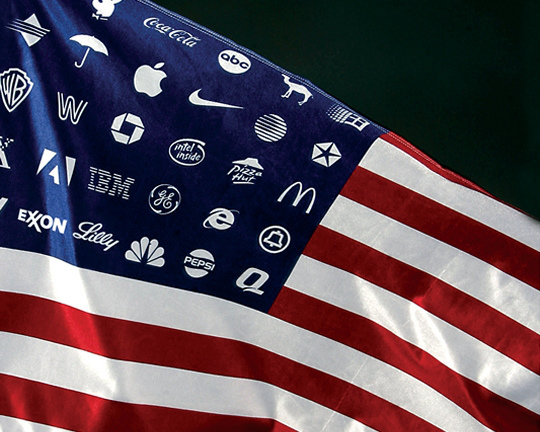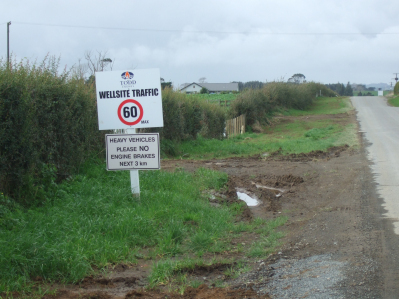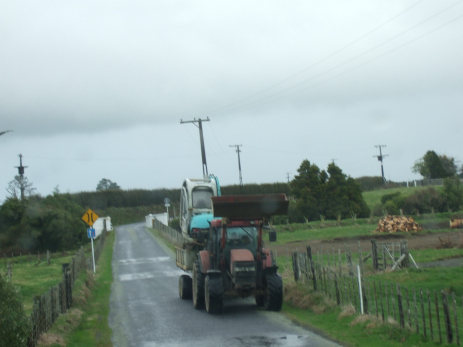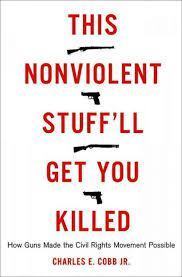Stuart Jeanne Bramhall's Blog: The Most Revolutionary Act , page 1359
July 10, 2014
The Care and Feeding of Intestinal Bacteria
My personal knowledge and understanding of intestinal bacteria stems from being diagnosed with a Clostridium difficile in 2012. C. difficile is an opportunistic intestinal infection that typically develops when excessive antibiotic exposure kills off normal gut bacteria. According to Dr Thomas Borody, the Sydney gastroenterologist I consulted, I most likely became infected with C difficile in 1993 owing to excessive use of broad spectrum antibiotics for a chronic sinus infection. For 19 years other doctors dismissed my extremely debilitating symptoms (constant watery diarrhea, pain and insomnia) as “irritable bowel syndrome” and told me I had to live with them.
Borody, founder and director of Sydney’s Center for Digestive Diseases, is world renowned for pioneering the use of fecal transplantation to treat C. difficile, ulcerative colitis and other bowel disorders triggered by an imbalance of intestinal bacteria. A growing number of doctors and holistic practitioners have come to regard intestinal bacteria, collectively known as the “microbiota” as a vital organ like the brain, liver and kidneys.
Regretfully fecal transplants didn’t work for me. My symptoms persisted until December 2013, when a chance encounter with a local chemist turned me onto the GAPS diet.
Gut and Psychology Syndrome
Dr Natasha McBride, a British neurologist with a postgraduate degree in nutrition, first developed the Gut and Psychology Syndrome (GAPS) diet for her autistic son. Like most autistic children, her son had major bowel problems in addition to the autism. Researchers have since uncovered links between endotoxin-producing intestinal bacteria, “leaky gut” syndrome and other neuropsychological conditions, such as schizophrenia, depression and ADHD.
The basic premise of the diet, which draws from the Weston A Price diet (see The Taboo Against Animal Fats) and the Specific Carbohydrate Diet (SCD), is to suppress the growth of pathogenic bacteria by eliminating the sugar and starches they feeds on, while simultaneously promoting the growth of healthy bacteria by taking probiotics and eating fermented foods.
McBride recommends that all patients begin with a strict elimination diet aimed at controlling the diarrhea. For the first six weeks, all I was allowed to eat was bone broth made from boiling stewing meat or fish heads, along with probiotics, juice from fermented vegetables, water kefir and kombucha. Once the diarrhea stopped, I was allowed to add new foods at six week intervals, starting with egg yolks (raw), then whole eggs (scrambled), then avocado, then nuts soaked in salt water overnight, cooked apple, and finally lentils, navy and lima beans soaked overnight in lemon juice or vinegar solution. Like most patients with C difficile, I have great difficulty digesting fibrous vegetables and fruits. Thus I have also been very gradually adding small amounts of cooked vegetables.
At the end of 18-20 months, I am allowed to cautiously allow starchy foods, starting with new potatoes and eventually sprouted buckwheat. After 24 months, I can cautiously add very small amounts of other grains, such as rice, oatmeal (soaked) and quinoa.
Even after the C difficile resolves, I can never return to a typical Western diet, with its heavy emphasis on carbohydrates, sugar and processed food, owing to demonstrated links with many chronic illnesses, such as cancer, diabetes, arthritis and heart disease (I discuss this in The Taboo Against Animal Fats).
My Total Life Makeover
Given the high stress fast paced lifestyle most of us lead, westerners find it extremely difficult to totally eliminate processed foods, sugar and starch from their diet. For the past six months, I have spent most of my waking hours shopping, cooking and learning to make fermented vegetables, water kefir and almond milk yoghurt (both dairy and soy products are forbidden). The first six weeks were the hardest, due to the copious amounts of fat I had to consume in my bone broth to compensate for the calories I previously derived from sugar, rice and potatoes. McBride is very explicit: patients must eat all the fat off the stewing bones they use to prepare the bone broth.*
After six months on the diet, I feel the sacrifice is definitely worth it. After 20 years of nearly constant diarrhea, pain and insomnia, it’s like a miracle to feel normal again.
Now the only major issue in my life is a social disease called monopoly capitalism.
*I admit to cheating a bit on this requirement by substituting coconut oil (which is allowed on the GAPS diet) for half of the animal fat. I am extremely concerned about the high concentration of industrial toxins found in animal fats and dairy products. Classified as endocrine disruptors, many of these toxins mimic estrogen, which is promotes the development and growth of breast cancer.
photo credit: jamesjoel via photopin cc


July 8, 2014
The Taboo Against Animal Fat
(The first of two posts about the damaging effect of the western diet on intestinal bacteria and human health.)
As a traditionally trained physician, I watch with horror and dismay as for-profit corporations intrude ever deeper into so-called evidence based medicine. I have written at length about the role of Big Pharma in corrupting good medical practice to promote the sale of prescription pharmaceuticals – and their bottom line (see Menopause: Made in the USA and Drug Companies: Killing Kids for Profit). The role of Food Inc in the dietary recommendations doctors (and government) make to patients and the public at large are even more insidious and damaging.
The current taboo against saturated animal fats is a case in point. For the past thirty years, doctors and government agencies have been lecturing us that diets high in saturated animal fats (found in red meat, whole milk, eggs, butter and lard) cause high cholesterol levels, heart disease and stroke. They have persisted in this three decade campaign against animal fat – despite the total absence of scientific research supporting a link between fat intake and high cholesterol levels – or heart disease and and stroke. In fact, growing evidence suggests just the opposite: diets low in saturated fats and high in sugar and refined carbohydrate promote obesity, type 2 diabetes, high cholesterol levels, high blood pressure, heart disease and stroke.
In other words, government and the medical fraternity have it backwards. Worse still, it appears that their purely theoretical (based on no evidence) phobia against animal fat may be the single most important factor in the current epidemic of obesity and type 2 diabetes.
An Unproven Hypothesis
The current taboo against animal fats is based on a hypothesis first promoted forty years ago when I was in medical school. The theory works like this: consumption of foods high in cholesterol and saturated fats promotes high levels of blood cholesterol, which lead to calcified plaque formation in arteries, which restrict blood flow to the heart and brain, as well as increasing blood pressure by making blood vessels less elastic.
There’s a credible body of research linking high cholesterol levels to plaque formation and the latter to high blood pressure, heart attack and stroke. However there’s no research whatsoever linking diets high in animal fats and cholesterol to high blood cholesterol levels.
In March, Annals of Internal Medicine published a metanalysis of 72 scientific studies on the effect of different fats on heart disease. The authors conclude there is insufficient research evidence to support guidelines discouraging consumption of saturated animal fats.
The Work of Weston A Price
A growing body of evidence suggests that diets low in saturated fats are, in fact, harmful to human health. Many of these studies were inspired by the work of dentist Weston A. Price in the 1930s. Puzzled that Maori, Australian aboriginals and other indigenous groups experienced no tooth decay prior to adopting a western diet, Price studied their dietary habits. To his surprise, he discovered it wasn’t the direct effect of sugar on tooth enamel that caused cavities. His patients developed tooth decay because diets high in sugar and refined carbohydrates were deficient in basic nutrients essential for human health. When he helped them alter their diets, his patients not only avoided further tooth decay but healed existing cavities.
One of Price’s discoveries was that animal fats* provide essential fat-soluble vitamins (A, D, E and K) that play a vital role in the absorption of other nutrients essential for hormonal and neurological function and protection against chronic diseases, such as cancer and heart disease.
The Role of Intestinal Bacteria
More recent studies have elucidated the mechanism by which diets high in sugar and refined carbohydrate predispose to both high cholesterol levels and obesity. Some of this research is summarized in an April 2013 article in Mother Jones Are Happy But Bacteria Key to Weight Loss?
The article explains how high sugar and refined carbohydrate diets, coupled with massive antibiotic overuse in medicine and factory farming**, promote the growth of gram negative, endotoxin-producing intestinal bacteria. When endotoxin is absorbed into the bloodstream, it sets up a wide ranging inflammatory response that can manifest a variety of effects, including arthritis, eczema, psoriasis and neuropsychological syndromes such as autism, Asperger’s disorder, schizophrenia and ADHD. A number of studies suggest that high cholesterol levels are also an inflammatory response to this endotoxin. Others link endotoxin to inflammatory damage in the brain’s appetite center. An impaired appetite center will cause people and animals to eat indefinitely without ever feeling full.
The Mother Jones article also describes several studies in which obese patients lost weight by simply suppressing endotoxin-producing bacteria – by taking probiotics and eating fermented foods containing beneficial bacteria.
*The contamination of animal fats and dairy products, even when produced organically, with fat-soluble pesticides and other industrial toxins makes choosing “safe” saturated fats somewhat problematic. Classified as endocrine disruptors, many of these toxins mimic estrogen, which promotes the development and growth of breast cancer. For this reason, I prefer coconut oil as my saturated fat of choice.
**Factory farmed animals are routinely fed antibiotics to hasten and maximize growth.
To be continued.
photo credit: {Guerrilla Futures | Jason Tester} via photopin cc


July 6, 2014
The Tyranny of Opinion Polls
In many western democracies, the corporate media has become extremely sophisticated at using opinion polls to manipulate both public sentiment and election results. These polls are made out as a scientifically valid representation of voter sentiment. Pollsters choose a small sample (between 500 and 10,000) of phone numbers at random, ring them and question the people who answer about their political views and/or candidates they support. The results are tabulated and paraded by the media as representing the population at large.
Unbeknownst to the public, these voter surveys are neither scientific nor representative of the public at large. Even more sinister is the secondary purpose they serve in discrediting anti-corporate, so-called “extremist” candidates and parties. Because all opinion polls exclude young, low income and minority voters, conservative candidates and parties always achieve more favorable poll results than they actually enjoy.
The Prevalence of Cellphone-only Homes
Opinion polls become less and less reliable as more and more young and low income people opt for cellphone- only households. The Center for Disease Control estimate that landline-free homes are increasing between 3-5% a year.
The most recent CDC study (2013) shows that 39.4% of all US households have no land line. Young people and low income and minority families the most likely to live in cellphone only homes:
65.6% of adults aged 25-29 live in homes with no land line.
59.9% of adults aged 30-34 live in homes with no landline
Hispanic adults (50.5%) are more likely than non-Hispanic adults (32.9%) to live in cellphone only homes.
59.7% of adults renting their home have no land line, more than twice the rate (25.4%) for home owners.
54.7% of adults living below the poverty line have no line line.
Excluded from Opinion Polls
A four-year-old Pew Research Center study found that Democrats ranked 7% lower in public opinion polls that excluded cellphones. With the estimated 20% increase in cellphone-only households in the last four years, that percentage will have grown proportionately.
Gallup, to their credit, now includes some cellphones in their political polling. Even so, cellphone polling introduces a variety of logistical problems affecting its validity. There are no standard directories of cellphone numbers, and many states ban randomized computer generation off cellphone numbers. Cellphone users (especially those whose plans bill them for receiving cellphone calls) are also far more likely to reject a call from an unknown phone number.
Opinion Polls in New Zealand
The percentage of cellphone-only households (estimated at 12-14%) is still quite a bit lower in New Zealand than the US. Even so, Kiwi pundits are beginning to question the validity of voter surveys that exclude specific demographic groups by refusing to ring cellphones.
Why, I wonder, is it still a total non-issue in the US, where an estimated 40% of households are routinely excluded from opinion polls?
photo credit: JR_Paris via photopin cc


July 4, 2014
How to Stop a Foreclosure
Or Get a Cash Settlement Following Foreclosure
In 2014 most home foreclosures can be stopped, through a myriad of federal and state programs that have sprung up. Given that hundreds of thousands of families continue to lose their homes every month, it’s really sad how few Americans are aware of this programs. Clearly Wall Street banks and the corporate media don’t want struggling families to know about these programs.
Fix My Payment (www.fixmypayment.com) is a free website and advisory service for homeowners who have lost homes to foreclosure or who are currently struggling with mortgage payments.
Many of the mortgage relief programs listed on the Fix My Payment website stem from settlements the banking industry has made with the Department of Justice, the Federal Reserve, the Office of the Comptroller and various states following criminal indictment for predatory lending practices (i.e. banks sold subprime mortgages to low income borrowers they couldn’t possibly repay) and fraudulent so-called “robo-signing” foreclosures. Others are federal programs enacted in 2009 as part of the Obama administration’s recovery package.
Below are some specific programs:
1. Department of Justice Settlement with Ally/GMAC, Bank of America, Citigroup, JP Morgan Chase and Wells Fargo in predatory lending indictment
Homeowners (and foreclosed homeowners) with mortgages issued by any of the above banks are eligible for mortgage relief under the following conditions:
Financial hardship ($17 billion available for principal reduction)
Upside down mortgages in which the property is worth less than the mortgage loan ($3 billion in refinancing relief)
Borrowers lost property to foreclosure between January 1, 2008 and December 31, 2011
2. Federal Reserve and Office of Comptroller settlement with Bank of America, Citigroup, Wells Fargo, JP Morgan Chase, Aurora Loan Services. MetLife Bank, PNC Financial Services Group, Sovereign Bank, SunTrust Banks and US Bancorp in wrongful “robo-signing” foreclosure indictment (i.e. banks foreclosed on homes without proof of legal title).
Borrowers with mortgages with the above banks are eligible for $3.3 billion in cash settlements if they have lost their home due to foreclosure and $5.2 billion in principal and/or interest reduction to existing mortgages (in cases of financial hardship).
3. Home Affordable Modification Program (HAMP)
Federal assistance the Obama administration enacted in 2009 providing financial incentives for banks and loan servicing companies to rewrite loan terms to help troubled borrowers (excludes mortgages owned or guaranteed by the government-sponsored enterprises Fannie Mae and Freddie Mac).
4. HAMP-VA, HAMP-FHA, HAMP-USDA
The above programs provide incentives for banks and loan servicing companies to write loan terms for mortgages guaranteed by the VA, the Federal Housing Administration or the US Department of Agriculture. (excludes mortgages owned or guaranteed by the government-sponsored enterprises Fannie Mae and Freddie Mac).
5. Housing Affordable Refinance Program (HARP)
Federal assistance the Obama administration enacted in 2009 providing financial incentives for banks and loan servicing companies to rewrite loan terms to help troubled borrowers with mortgages owned or guaranteed by the government-sponsored enterprises Fannie Mae and Freddie Mac.
6. Keep Your Home California (KYHC)
California residents are also eligible for four state programs:
The Unemployment Mortgage Assistance Program – helps homeowners who are currently unemployed and receiving California EDD unemployment benefits.
The Mortgage Reinstatement Assistance Program – helps homeowners who have fallen behind on their payments and need help in reinstating their loan.
The Principal Reduction Program – helps homeowners who have experienced a financial hardship along with a drop in the home’s value.
The Transition Assistance Program – provides relocation up to $5,000 in relocation funds to help eligible homeowners transition into a new housing situation after going through a deed-in-lieu or short sale.
Free Personal Assistance
In addition to the numerous options listed on their website, people can also phone (909) 937-2400 or visit a mortgage adviser (without charge) if they live in Los Angeles. In addition to recommending specific programs homeowerns can apply for, Fix My Payment customer service representatives seem to know exactly what documents to file to halt foreclosure proceedings.
The Non-Existent Recovery
Economists predict no end in sight to the present foreclosure crisis. Despite manipulation of the “official” unemployment rate by the Obama administration and the corporate media, the percentage of employed Americans of working age has flat lined. According to the Department of Labor’s own statistics, the percentage of American families in which no one has a job stands at 20%. The percentage of unemployed working age adults stands at 41%. Prior to the 2008 economic downturn, this figure had been stable at 35-37% for nearly a decade.
With the recent news that the US economy shrank by 2.9% in first quarter 2014, the potential for new job creation looks extremely bleak. The technical term for a shrinking economy is deflation. Deflation leads to a downward spiral. A shrinking economy means less money in circulation. Low demand forces retailers to reduce their prices, while consumers postpone purchases in anticipation prices will drop further. As sales continue to decline, companies lay off more workers, which makes finding new jobs even more difficult.
photo credit: JefferyTurner via photopin cc


July 2, 2014
Is Your Boss Pocketing Your State Income Tax?
Corporate Welfare for Goldman Sachs, Walmart and 2,700 Other Companies
According to investigative journalist David Cay Johnston, more than 2,700 companies have secret agreements to keep the state income tax they withhold from your paycheck.
Goldman Sachs, Walmart, Chrysler, Ford, General Motors, Nissan, Mitsubishi, Motorola, Proctor and Gamble, AMC Theaters, Toyota and Electrolux are but a few of the big name companies involved.
As Johnston writes in a 2011 Reuters column:
“Instead of paying for police, teachers, roads and other state and local services that grease the wheels of commerce, Illinois workers at these companies will subsidize their employers with the state income taxes they pay. The deal to let employers keep half or all of their workers’ state income taxes represents a dramatic expansion of a little-known trend in the law: diverting taxes from public purposes to private gain.”
As of April 2012, the states which have signed these secret agreements included Colorado, Connecticut, Georgia, Illinois, Indiana, Kansas, Kentucky, Maine, Mississippi, Missouri, New Jersey, New Mexico, North Carolina, Ohio, South Carolina, Utah.
Read more at Taxed by the Boss
photo credit: watchingfrogsboil via photopin cc


June 30, 2014
Marijuana Cash-Only Business in Colorado

Owing to recent legalization, recreational marijuana use is a growth industry in both Colorado and Washington State. In Colorado alone, annual turnover is projected to reach $10.2 billion by 2018. Yet owing to archaic federal banking laws, it remains a cash-only industry.
A BBC Business report gives the example of Pinkhouse Blooms. A chain of five marijuana dispensaries grossing over $100,000 a day, they remain a cash-only business. No Denver bank will give him a checking account. As Avinash Tharoor reports in the Huffington Post, the FBI is pursuing Bank of America, JP Morgan and HSBC for laundering billions of dollars of Mexican cartel money. Meanwhile they thumb their nose at legal marijuana merchants.
Relying on armored cars and armed security guards, owner Elliott Klug uses cash to pay his suppliers and employees – as well as $35,000 in monthly sales tax and $45,000 in state licensing fees.
Federal Laws Encourage Money Laundering
Although the Obama administration has directed federal attorneys not to prosecute marijuana users, growers, and distributors in states which have legalized marijuana (for recreational and/or medical use), banks that do business with marijuana producers and distributors remain in legal limbo. At present all federally insured banks that accept deposits from “drug dealers” are subject to suspension of their banking license and criminal prosecution under federal drug racketeering laws.
Both the Bank Secrecy Act and the Anti-Money Laundering Act were enacted to prevent money laundering. Ironically they do just the opposite in the eleven states with legal marijuana dispensaries. Cash-only businesses are notoriously susceptible to both tax evasion and money laundering. Without bank records, there’s no audit trail. Federal and state authorities only have the owner’s say-so for the amount of business they take in.
In February the Obama administration issued “guidance” that the Justice Department and FinCEN (under the Treasury Department) is “unlikely” to prosecute banks provided they meeting specified conditions, including reporting suspicious criminal activity to law enforcement. Unfortunately this “guidance” offers no real legal immunity, as all marijuana use is still illegal under federal law.
In 2011 Congressman Jared Polis (D-Colorado) tried to legislate immunity for banks doing business with medical marijuana dispensaries with his proposed Small Business Banking Improvement. The bill died in committee, and it doesn’t appear that similar legislation is forthcoming any time soon. Not if a myopic press release by Senators Charles Grassley and Diane Feinstein, as co-chairs of the Senate Caucus on International Narcotics Control, is anything to go by.
Their joint letter and press release castigate the Obama administration for “assisting those businesses that seek to inject the proceeds of criminal activity into the nation’s financial system.”
Makes you wonder when Feinstein was last in California, the state she supposedly represents. California was the very first state to set up legal marijuana dispensaries in 1996 when voters passed an initiative legalizing marijuana use for medical purposes.
Big Boost from State Marijuana Tax
Both Colorado and Washington have suffered major budget difficulties since the 2008 downturn. And in both states, legalizing (and taxing) recreational marijuana use promises a major cash injection for state coffers.
In Colorado, retailers pay a 10% marijuana tax in addition to 2.9% general sales tax to the state. County and city authorities may charge additional tax. In Denver, for example, the total sales tax can reach as much as 21%. This is in addition to a 15% excise tax charged on marijuana as it leaves the cultivation facility.
Washington charges a 25% excise tax on sales at each transaction level: from the producer to the processor, the processor to the retailer and the retailer to the customer. This is in addition to B&O (Business and Occupations) and sales tax all businesses pay. As of July 8, producers will be licensed by the Washington State Liquor Control Board to sell directly to consumers.
Small Local Credit Unions Do Business with Washington Dispensaries
In Washington State, two brave local (federally insured) credit unions (Salal Credit Union and Numerica Credit Union) have announced their intention to do business with marijuana dispensaries when they begin operation July 8. Unlike the big boys, they aren’t laundering money for the Mexican cartels or, presumably, speculating on derivatives and food futures
photo credit: Wikimedia Commons
Cross posted at Veterans Today


June 28, 2014
Reverend Billy vs Monsanto Robot Bee Drones
Below is a ritual Robobee exorcism Reverend Billy and the Church of Stop Shopping performed in the Harvard labs on May 25,2014
The world is facing massive die-off of bee populations, thanks to heavy use of pesticides manufactured by Bayer and Monsanto.
The loss of bee populations severely threatens global food production (70-80% of plant and animal foodstuffs depend on bee pollination).
In response, the EU has banned pesticides found to be harmful to bees.
In contrast the US Department of Agriculture (USDA) has declined to enact a similar ban in the US, largely due to massive congressional lobbying by Monsanto.
Instead Harvard University is researching the creation of tiny drone bees – called Robobees – to replace the bees killed off by pesticides. Unbelievable, isn’t it – the lengths scientists and governments will go to to avoid doing the right thing.
Support the work of Reverend Billy and the Church of Stop Shopping at http://www.revbilly.com/


June 26, 2014
Our What the Frack Tour – June 21, 2014
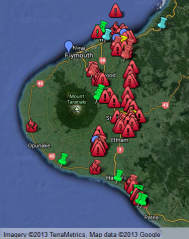 legend: red triangle: fracking well sites
legend: red triangle: fracking well sites
red flame: gas/oil production stations
red pin: deep well injection sites
green pin: “land farms” and land treatment sites.
source: Climate Justice Taranaki
We Have Been Invaded
As you can see from the above map, pristine Taranaki dairyland has been totally invaded and colonized by foreign oil and gas companies. New Zealand’s lax regulatory environment has produced a feeding frenzy. Eager to offshore as much profit as possible, they have transformed our clean green countryside into an industrial site.
A recent report by the New Zealand Commissioner for the Environment is highly critical of both Taranaki Regional Council (TRC) and New Plymouth District Council for their failure to regulate foreign energy companies in accordance with existing New Zealand law.
The PCE, bless her, makes the link between fracking and climate change front and center in her report. In her introduction, she questions the common assertion that natural gas is a so-called transition fuel, given its substantial contribution to atmospheric CO2. She also calls on the New Zealand government to specify exactly how they will fulfill their commitment to reduce New Zealand’s greenhouse gas emissions to 5% below our 1990 emissions by 2020.
Improper Disposal of Fracking Waste
Her report goes on to chastise TRC for the failure to regulate discharge of fracking waste. Despite vociferous complaints from local farmers and residents, TRC continues to permit discharge of untreated fracking waste into streams that provide water for livestock and, and in several cases, human beings.
She’s especially critical of TRC’s use of “visual inspection,” rather than chemical testing, to assess the water quality of these streams. One particularly silly monitoring report refers to inspectors signing off on water quality because they heard frogs singing.
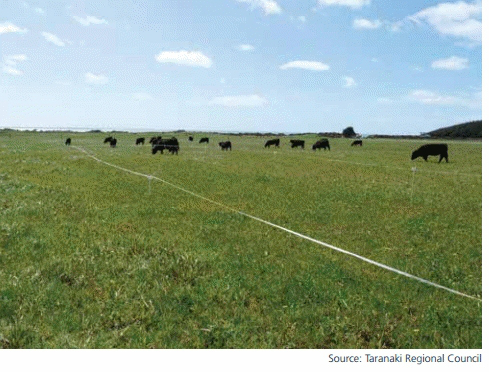 “Land farmed” site with grazing cattle
“Land farmed” site with grazing cattle
Another common disposal method is to spread wastes on pasture and grow grass and graze cows on it – without testing the cows, grass or milk for heavy metals, barium, benzene, hydrocarbons or other chemicals commonly found in fracking waste.
The experience with toxic sludge in the US is that heavy metals and other toxic chemicals bio-accumulate in plants grown in contaminated soil
Given given that dairy products are New Zealand’s number one export, this so-called land farming could do major damage to our country’s economy. Especially as China, our major export market, is already exquisitely sensitive to the milk contamination issue.
Emergency Evacuation Plans
Another major concern in the PCE’s report relates to the Emergency Evacuation Plans fracking companies are required to file for each drill and production site. Many fracking sites are located less than 500 meters from private homes.
As here
here
here
and here
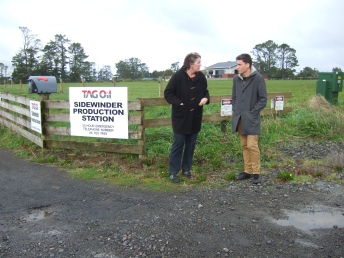 Sarah Roberts and Robert Moore – Green Party candidates for New Plymouth and Taranaki-King Country
Sarah Roberts and Robert Moore – Green Party candidates for New Plymouth and Taranaki-King Country
For some reason, none of these residents have been notified that they are slated for evacuation in the case of an accidental gas release or explosion. As an example there are 36 owners and occupiers identified on the TAG Oil emergency management plan (gas release/spill contingency plan covering 500m) at Sidewinder A wellsite. These owners and occupiers will not be aware of this.
Drop in Property Values
The owners of the last property pictured above are desperate to sell it. The value of properties located adjacent to fracking wells have plummeted.
This is due to the constant noise, exposure to air and water pollutants, heavy industrial traffic
and flaring

What’s more the property adjacent to fracking wells can’t be insured, owing to the risk of leaking wells, inadvertent gas releases and explosions. Under New Zealand law, the property owner assumes liability for an abandoned well site that leaks.
Todd Oil (affiliated with Shell) has recently agreed to top up sales proceeds of land owners forced to sell their property at a loss. But if you live adjacent to a Tag Oil or Greymouth Petroleum fracking site, you’re out of luck.
Health Consequences of Fracking
Because the PCE is only charged with addressing environmental issues, her report doesn’t address the nosebleeds, rashes, cancer clusters and other health issues associated with living near a fracking site.
Nor the disastrous effect of being surrounded by fracking rigs on overall well beings and quality of life. People shouldn’t have to live this way. Why should Taranaki residents sacrifice their livelihoods and the health and well being of their children for the benefit of foreign oil companies?
Community Meeting Regarding Norfolk School
Our What the Frack Tour finished up with a community meeting at Norfolk Hall, a Taranaki country hall between Inglewood and Stratford. TAG Oil is applying to drill their Sidewinder B well site 600 meters from Norfolk Primary School. This isn’t about a couple of exploratory wells. This is about the the potential drilling an on-going extraction of eight wells.
As came out at the meeting, prevailing south westerly winds would make emergency evacuation of the students impossible in the case of an accidental gas release. These can and do occur at Taranaki fracking sites.
Read follow up letter from to Taranaki Daily News from one attendee: Not the Good Oil


June 24, 2014
Memoir of a Standup Revolutionary
My Booky Wook: A Memoir of Sex, Drugs and Standup
By Russell Brand (2007 Hodder and Stoughton)
Book Review
I have a particular interest in the background influences that radicalize people. In my view, this is the main value of Russell Brand’s 2007 autobiography. I had never heard of Brand, a 38 year- old British stand-up and comedian and TV personality, until his interview with talk show host Jeremy Packman went viral on YouTube. Brand had just been selected to guest edit an issue of The New Statesman, an edition that featured his essay advocating revolution to overthrow the current political system.
The inspiration for the autobiography grew out of Brand’s treatment for drug, alcohol and sexual addiction. Making an uncompromising moral inventory of family and friends we have wronged in the course of our addiction is a major feature of all 12 step programs. Despite the tendency of most Step 4 confessions to be maudlin and self absorbed, Brand’s timing and zany self-deprecating humor carries over into his writing. My Booky Wook is well constructed and fast paced and any dull bits have been edited out.
Predictably Brand’s early history shares many common features with behavior disordered kids who go on to become revolutionaries. Like many gifted children whose intelligence is stifled, rather than encouraged, Brand used his cleverness to seek act attention and approval from his classmates. The more his teachers punished him for his disruptive behavior, the more he sought out the company of neighborhood drop outs, eventually getting caught up in their drug and alcohol use and petty criminal behavior.
Like many generation Xers, Brand had no working class allegiance as a child. Neither of his parents identified as working class. As a single mom, his mother was limited to low paid short term jobs with flexible hours, in order to accommodate her parenting obligations. Though most single mothers find themselves limited to similar dead end jobs, neither society nor their society nor the women themselves are inclined to view them as blue collar work. A perennial salesman (e.g. double glazing, water filters, market stalls), Brand’s father swallowed the myth that he was capable, if he worked hard enough, of creating his own future. Ironically his income was never sufficient to stretch to child support.
Brand himself only began to identify with his working class origins through his drug use. Establishing himself as a stand-up comedian required him to tour, and his heroin addiction required him to seek out the disadvantaged section of any new cities he visited. Impressed by the marked divide between the intense squalor he encountered and the lifestyles of the corporate elite, he began to educated himself politically by visiting Cuba and reading dissident writers like Noam Chomsky and Naomi Klein.
Link to Brand’s New Statesman essay: Is Utopian Revolution Possible?
Below Brand calls for revolution in Parliament Square:


June 23, 2014
Gun Ownership and the Nonviolent Civil Rights Movement
Charles E Cobb is a long time African American journalist who participated in the southern freedom movement etween 1962 and 1966. His purpose in writing This Nonviolent Stuff Will Get You Killed is to correct the revisionist “white” view of the 1960s civil rights movement.
The version of the civil rights movement taught in schools and universities is written by white historians who, for the most part, lay out historical events and omit the thinking that led to them. Or even worse, instead of asking movement veterans what they were thinking, offer a retrospective analysis of what they must have been thinking.
It was a problem Frederick Douglass frequently faced in his dealings with white abolitionists. Afraid he would appear “too learned” to be convincing, they told him, “Just give us the facts – we’ll take care of the philosophy.”
One important fact often “whitewashed” out of history is the use of guns in the southern civil rights movement. Guns have always been fundamental to rural life, in both black and white communities. In the 1960s, they were essential for the survival of black farming families – for hunting food, killing varmints in the garden and protecting themselves against terrorist raids by Night Riders and the Ku Klux Klan.
White southerners made it pretty obvious that they were prepared to kill African Americans – and their families – if they registered to vote. Despite his highly publicized use of nonviolence as a tactic, Martin Luther King had bodyguards who carried pistols to protect him. and Fanny Lou Hamer used a shotgun to protect her house against white “crackers.” Armed African American World War II and Korean War veterans – in some areas formally organized as The Deacons for Defense and Justice – carried weapons to protect workers from CORE (Congress of Racial Equality) and SCLC (Southern Christian Leadership Council).
No white people were ever killed by these guards: it was sufficient to convey the message that blacks were willing to defend themselves.
As Cobb points us, no white person is willing to die for white supremacy.
Cobb is a great story teller, and sheds important insights about the curious relationship between outside organizers and rural African American farmers as they set about building their trust.
It was my intention to embed Cobb’s 90 minute C-SPAN presentation about his book, but YouTube has censored the video by taking it down. So you have to click on the following link:
http://www.c-span.org/video/?319435-1/guns-civil-rights


The Most Revolutionary Act
- Stuart Jeanne Bramhall's profile
- 11 followers






